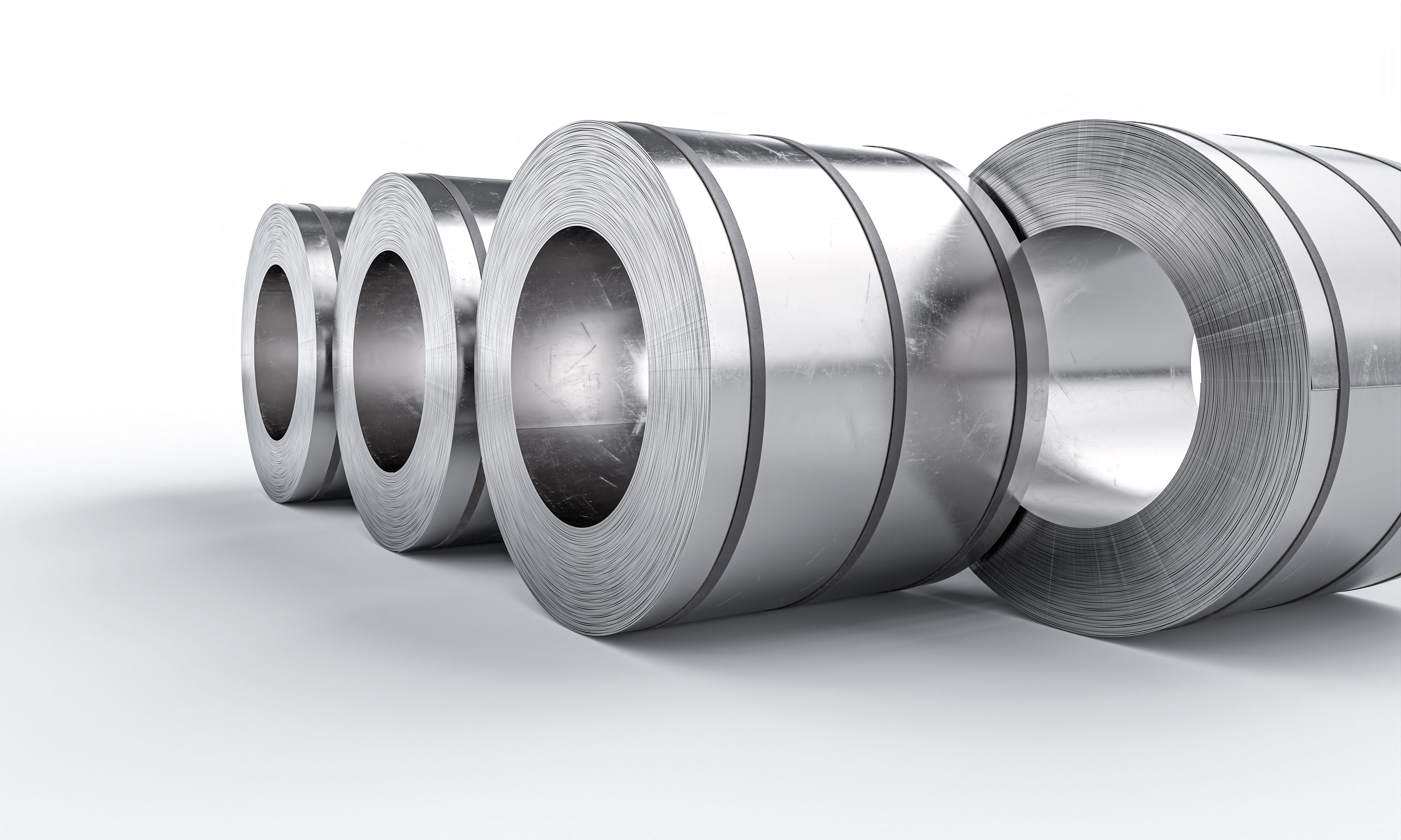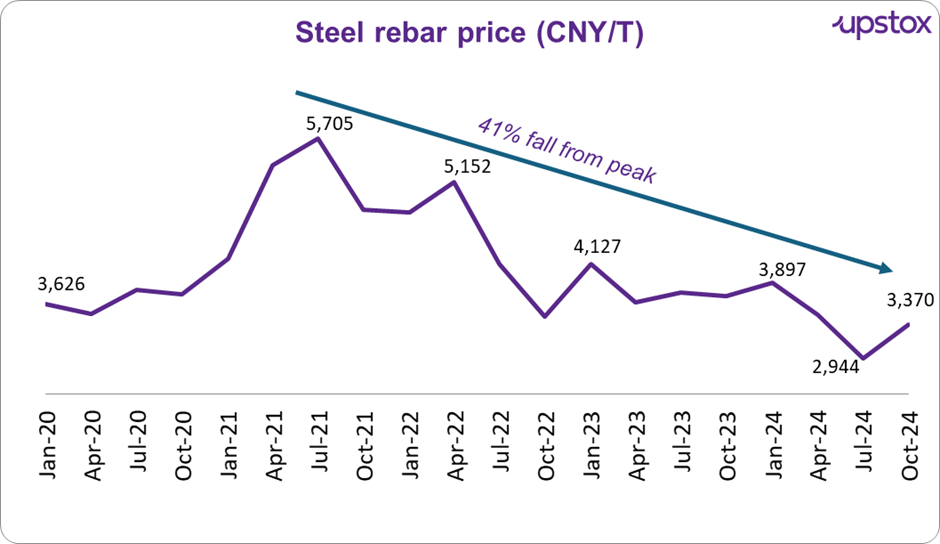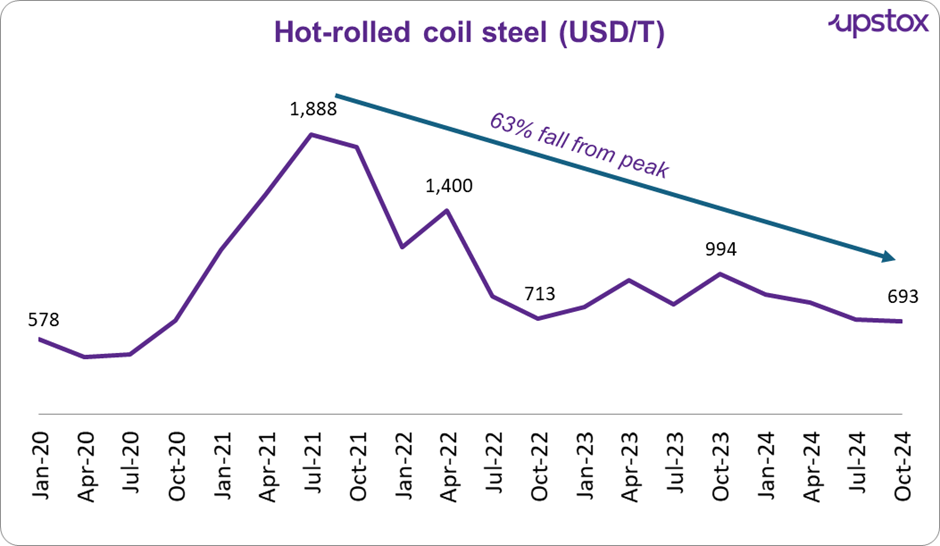Upstox Originals
Surplus and imports: Double trouble for India's steel sector
.png)
5 min read | Updated on October 20, 2024, 11:23 IST
SUMMARY
The steel industry is witnessing a global decline in prices, driven by weak Chinese demand and increased exports of cheaper steel. As a net importer of steel in FY25, India has also been impacted. While the price decline is beneficial for manufacturers, domestic steel producers are under pressure. This has also prompted the government to also review the situation and consider steps to alleviate the situation.

Falling steel prices has put pressure on manufacturers in India
The steel sector in India is navigating a turbulent period as prices continue to fall, driven by external competition and domestic factors. Cheaper imports, particularly from China and Vietnam, combined with surplus production, are pushing local companies into a tough spot. This trend could have wide-ranging implications across the industrial and construction landscapes.
But first some key terms to know
-
Steel Rebar: A steel bar used to reinforce concrete structures, enhancing their tensile strength and durability.
-
Hot-Rolled Coil Steel (HRC): Steel produced by heating and rolling steel slabs at high temperatures, resulting in a flat, coil-shaped product used in construction and manufacturing.
What’s happening globally?
-
Weak demand from China: China, the largest producer and consumer of steel, is experiencing a significant slowdown in its domestic market, particularly in construction and manufacturing. According to a report by S&P Global, at least 20% of China’s current steelmaking capacity will have to be cut to maintain balance.
-
Increased steel exports from China: To offload excess production, Chinese steelmakers are exporting more steel at lower prices. This flood of cheaper steel in the global market is putting a downward pricing pressure

Source: Tradingeconomics.com
-
Falling prices of raw materials: The cost of essential raw materials for steelmaking has been falling.
- Iron ore: Price has fallen from 214 USD/T in July 2021 to ~105 USD/T currently
- Coking coal: Price has corrected from ~342 USD/mt in Q1 CY23 to an average of ~211 USD/mt in Q3CY24
This reduces production costs for steelmakers, allowing them to sell steel at lower prices
What has been the trend in prices?
Steel prices have been on a downward trend for the past three years, as shown in the chart above.

Source: tradingeconomics.com
Recently, HRC prices have also hit a 3-year low.

Source: tradingeconomics.com
How does this impact India?
As can be seen in the chart below, India imported 9.6 million tons of steel in 2023, a 42.3% YoY increase, while exports have gone down by ~20%. To exacerbate the situation, India has recently become a net importer of steel. In the first five months of FY25, India exported 1.9 million tonnes of steel but imported 3.5 million tonnes.

Source: International Trade Administration, new articles
Factors affecting steel price in India
Increased Imports: Cheaper steel imports from China and Vietnam are undercutting local manufacturers, with prices close to domestic rates. Reports indicate that India's steel imports from China have reached a 7-year high! While lower prices can cut costs for manufacturers, they’re also squeezing the margins of steel producers. News reports indicate that the government will tighten the quality credentials to rein in large-scale dumping of substandard steel, largely from China

Source: International Trade Administration
Supply surplus: Domestic producers like JSW Steel, Tata Steel, and NMDC have ramped up production, leading to an oversupply and falling prices. As reported by Business Standard, these companies are also expanding their capacity, with JSW Steel and Tata Steel aiming for 40-50 million tonnes each by 2030, and NMDC targeting 100 million tonnes Apollo Tube is expanding to 5 million tonnes, while SYR is boosting its capacity from 1.2 to 2 million tonnes in the next two years.
Here is what the management of leading Indian steel companies has said
Tata Steel’s CEO & MD T. V. Narendran shared the following during the August 2024 concall:
"China is not competitive. They lose money at these prices. It is not that they are making money at these prices, in which case you can call them competitive. It is predatory pricing which is detrimental to the future of the industry in India. China exporting 100 million tons a year is not something the world can live with. China selling steel at less than $500 per ton when coking coal prices are $220 – 230 per ton defies logic. Import pressures are there and domestic cost pressures are also there, which is not good for the long-term health of the industry."
Adding to this, Mr. Anil Tulsiani, Director of Finance at Steel Authority of India Limited, mentioned during the same concall:
"The global steel industry continues to be impacted by several factors like high inflation and rising geopolitical uncertainties. The demand in China, the biggest producer and consumer of steel, is a cause for worry. The consumption in real estate investment has been consistently coming down. Though production in China during the first half of 2024 declined by 1.1% over the previous year, the growth in steel demand continues to be negative. As per WSA, the same is expected to contract by around 1% in 2025."
The table below lists some select steel manufacturers in India.
| # | Name | Market Cap ₹ Cr. | 3-Year Profit Growth (%) (2021-24) | 3-Year Stock Return (%) (2021-24) | EV / EBITDA | ROE (%) |
|---|---|---|---|---|---|---|
| 1 | JSW Steel | 2,50,023 | 2 | 13 | 12 | 12 |
| 2 | Tata Steel | 1,98,800 | -7 | 5 | 11 | 7 |
| 3 | Jindal Stainless | 62,643 | 94 | 64 | 14 | 20 |
| 4 | S A I L | 55,659 | -4 | 3 | 7 | 6 |
| 5 | Shyam Metalics | 25,388 | 7 | 36 | 14 | 12 |
| Average | 1,18,503 | 18 | 24 | 12 | 11 |
Source: Screener.in
Conclusion
As the steel industry grapples with falling prices, the long-term outlook hinges on a recovery in demand and balanced supply. Domestic steelmakers need strategic interventions to remain competitive amid global pricing pressures. How the sector adapts will shape the future of India's broader industrial economy.
By signing up you agree to Upstox’s Terms & Conditions
About The Author
Next Story
